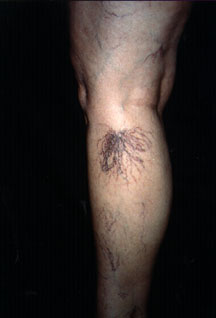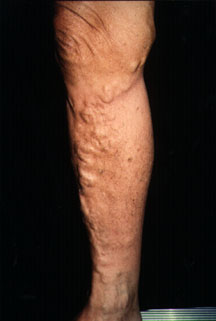Third trimester of pregnancy ( IV )
 • Hemorrhoids. Hemorrhoids are varicose veins in the rectum. Although they may occur at any time during pregnancy, they are most common during the third trimester due to the increased pressure of the growing fetus on the veins in the rectum. Constipation may also contribute to their development. Hemorrhoids can cause itching, soreness and bleeding. Women may benefit from drinking a large amount of fluids, increasing fiber consumption and eating whole grains, fruits and leafy green vegetables. Women should also avoid straining during bowel movements.
• Hemorrhoids. Hemorrhoids are varicose veins in the rectum. Although they may occur at any time during pregnancy, they are most common during the third trimester due to the increased pressure of the growing fetus on the veins in the rectum. Constipation may also contribute to their development. Hemorrhoids can cause itching, soreness and bleeding. Women may benefit from drinking a large amount of fluids, increasing fiber consumption and eating whole grains, fruits and leafy green vegetables. Women should also avoid straining during bowel movements. • Stretch marks. Stretch marks are red, pink, or purple streaks in the skin caused by the stretching of the skin. These scars, which usually appear over the thighs, buttocks, abdomen and breasts, most often develop in the second half of pregnancy. According to the National Women’s Health Information Center, approximately half of all pregnant women get stretch marks. Following delivery, most stretch marks fade to light lines.
• Stretch marks. Stretch marks are red, pink, or purple streaks in the skin caused by the stretching of the skin. These scars, which usually appear over the thighs, buttocks, abdomen and breasts, most often develop in the second half of pregnancy. According to the National Women’s Health Information Center, approximately half of all pregnant women get stretch marks. Following delivery, most stretch marks fade to light lines. • Rashes. During late pregnancy, some women may develop itchy red bumps on the abdomen. Although they are harmless, these bumps can spread to the buttocks, arms and legs, causing discomfort. The rash normally disappears following delivery.
 By the 26th week of pregnancy, the fetus is about 13 inches (330 millimeters) long and weighs approximately 1 ¾ pounds (794 grams). It will continue to grow and move, however, activity may be decreased due to the fact that the fetus now has less room. During this trimester, the expectant mother’s body will begin preparing for labor and delivery and the fetus will start moving down into the birthing position. As a result, the woman may notice the fetus moving down (dropping or a process called lightening) in the abdomen. By the end of the trimester, the average fetus is about 20 inches (508 millimeters) long and weighs about 7 pounds (3 kilograms).
By the 26th week of pregnancy, the fetus is about 13 inches (330 millimeters) long and weighs approximately 1 ¾ pounds (794 grams). It will continue to grow and move, however, activity may be decreased due to the fact that the fetus now has less room. During this trimester, the expectant mother’s body will begin preparing for labor and delivery and the fetus will start moving down into the birthing position. As a result, the woman may notice the fetus moving down (dropping or a process called lightening) in the abdomen. By the end of the trimester, the average fetus is about 20 inches (508 millimeters) long and weighs about 7 pounds (3 kilograms).












